Intel’s Sandy Bridge i7-2820QM: Upheaval in the Mobile Landscape
by Jarred Walton on January 3, 2011 12:00 AM EST- Posted in
- Laptops
- Intel
- Sandy Bridge
- Compal
Temperatures and Noise
Wrapping up our look at the Compal notebook, we measured the noise levels and temperatures at idle and at load. Since we don’t know if this particular configuration will even hit retail, we won’t dwell on it too much, but here are the results. Idle surface temperatures measured between 24C and 29C on the keyboard and palm rest, while the bottom of the notebook is slightly warmer and showed temps of 26-32C. Most of the notebook is close to room temperature, but near the CPU and exhaust at the back/middle the system is a bit warmer. Under heavy load (for over an hour), the temperatures increase, but the fan and dynamic CPU/GPU clocks keep things reasonable. The top temperatures increased to 24-33C, while the bottom measured 26-38C. Temperatures at the exhaust under load were around 44C. Here’s a shot of internal system temperatures, courtesy of HWMonitor.
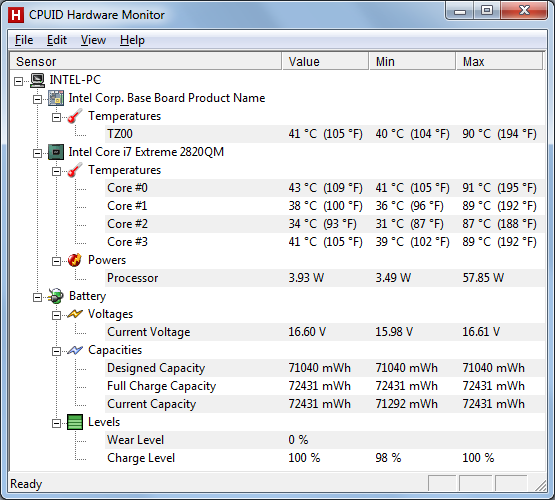
Using the same idle and load tests, we also checked noise levels. The BIOS on this particular setup allows you to configure two temperatures and fan speeds, with the defaults being 75% fan speed at 55C and 100% fan speed when the CPU hits 70C. There are apparently other settings in effect, however, as we noticed four distinct fan speeds. Anyway, below about 45C, the fan shuts off and you have a silent notebook. Given the low power requirements and CPU temperatures at idle, the system fan is usually off under light loads, with the result being system noise right at the floor of our testing environment/equipment: 30dB. Occasionally the fan will spin up and create about 32.5dB of noise, but this usually only lasted a few seconds at most. Running heavy loads will usually get the fan at maximum speed after 20 seconds or so, at which point we measured 41dB; that’s still tolerable considering how infrequent such loads usually are, though if you do heavy number crunching or video editing you might end up with a moderately noisy notebook.
Average Resolution, Average Performance
What about the LCD? We’ve only looked at a few 17.3” notebooks, with their associated 900p resolution. So far we’ve had the Clevo W870CU (Chi Mei N173O6-L02), the ASUS X72D/K72DR with the same panel, and the Dell Studio 17 (with an unknown panel). The Sandy Bridge test system apparently comes with a Seiko Epson 173KT panel, but the characteristics are no better—and sometimes worse—than the other 17.3” 900p displays we’ve looked at.

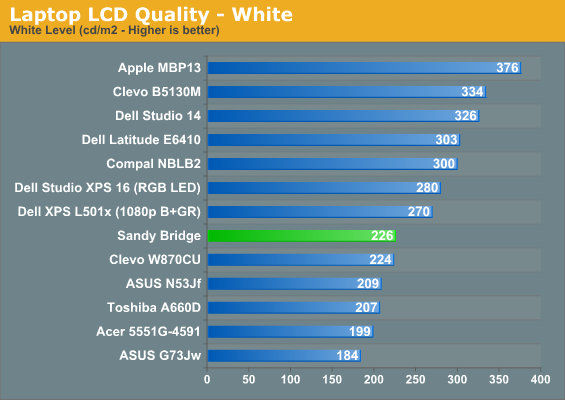
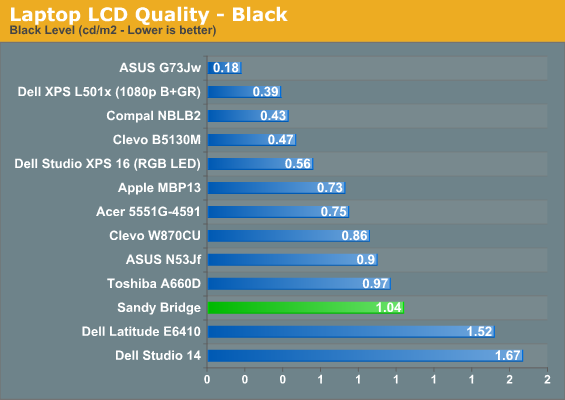

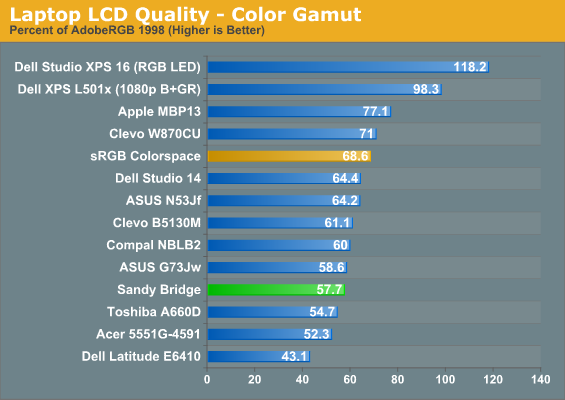
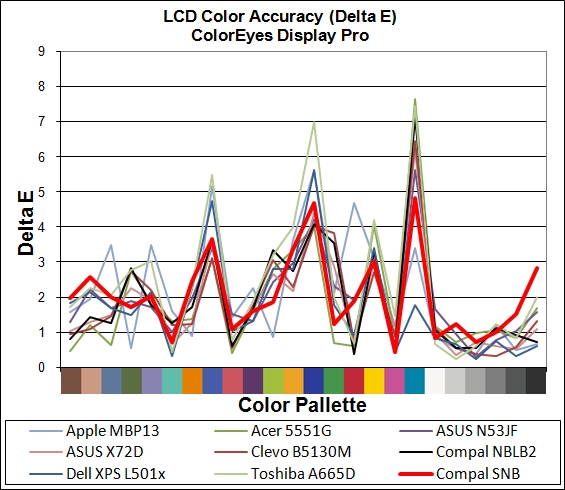
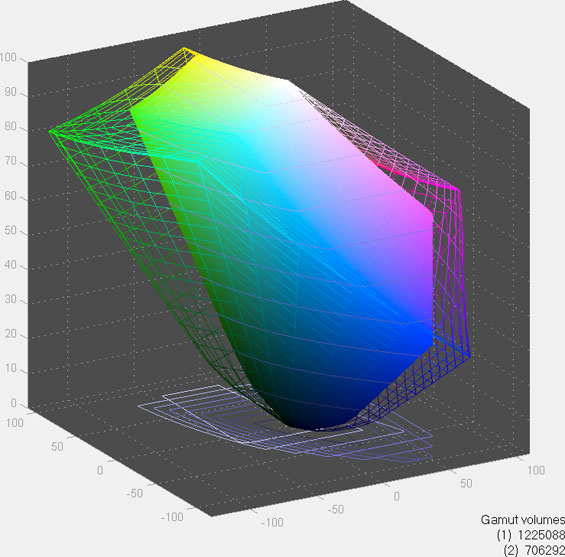
Color gamut is pretty good, and accuracy is perhaps a bit better than average, but the contrast is a disappointing 217:1 and the maximum brightness is a none-too-impressive 226nits. While there are certainly worse LCDs out there, this particular panel is yet another that fails to rise above mediocrity. We have yet to test a 900p display that has impressed us, so consider this a warning.










66 Comments
View All Comments
mtoma - Monday, January 3, 2011 - link
Something like Core i7 1357M could make Win 7 tablets temporarily viable. Remember that in the ultra portable space the big words are: multitasking, dual core processors (like Cortex A9). So, realistically, we need ULV dual-core Sandy Bridge.JarredWalton - Monday, January 3, 2011 - link
The i7-640M runs at 1.2GHz minimum and 2.26GHz maximum. The i7-2657M runs at 1.6GHz minimum and 2.7GHz maximum. (Actually, minimum on all the Core 2nd Gen is 800MHz when you aren't doing anything that needs more speed.) That would be 33% faster base speed and up to 19% higher max speed, just on clock speeds alone. However, you forgot to factor in a round 20-25% performance increase just from the Sandy Bridge architecture, so you're really looking at anywhere from 19% (bare minimum) to as much as 66% faster for normal usage, and things like Quick Sync would make certain things even faster.DanNeely - Monday, January 3, 2011 - link
You've got a limited range of TDP that any given architecture will be good in. According to Intel (at the time of the atom launch) things start getting rather ragged when the range gets to 10x. Until Core2 this wasn't really an issue for Intel because the p3 and prior's top end parts had sufficiently low TDPs that fitting the entire product line into a single architecture wasn't a problem. It didn't matter much in the P4 era because the Pentium-M and Core 1 were separate architectures and could be tuned so its sweet spot was significantly lower than the desktop P4. Beginning with Core2 however Intel only had a single architecture. The bottom tier of ULV chips suffered due to this, and on the high end the fact that overclocking (especially voltage OCing) was very poor on the performance gain/increased power consumption scale.The atom is weak as you approach 10W because it was designed not as a low end laptop part (although Intel is more than willing to take your money for a netbook); but to invade ARM's stronghold in smartphones, tablets, and other low power embedded systems. Doing that requires good performance at <1W TDP. By using a low power process (instead of the performance process of every prior Intel fabbed CPU) Moorestown should finally be able to do so. The catch is that it leaves Intel without anything well optimized for the 10-15W range. In theory the AMD Bobcat should be well placed for this market, but the much larger chunk of TDP given to graphics combined with AMDs historic liability in idle power make it something of a darkhorse. I wouldn't be surprised if the 17W Sandybridge is able to end up getting better battery life than the 10W Bobcat because of this.
Kenny_ - Monday, January 3, 2011 - link
I have seen in the past that when Mac OS X and Win 7 are run on the same machine, Mac OS X can have significantly better battery life. Is there any chance we could see what Sandy Bridge does for battery life under Mac OS X?QChronoD - Monday, January 3, 2011 - link
This was a test machine that intel cobbled together. Give it a few weeks or months after some retail machines come out, and then I'm sure that someone in the community will have somehow shoehorned OSX onto one of the machines. (Although I don't know how well it would perform since they'd probably have to write new drivers for the chipset and the graphics)cgeorgescu - Monday, January 3, 2011 - link
I think that in the past we've seen MacOS and Win7 battery life comparison while running on the same Mac, not on the same Acer/Asus/Any machine (cause MacOS doesn't run on such w/o hacks). And I suspect Apple manages better power management only because they have to support only few hardware configurations (so doing optimizations especially for that hardware), it's a major advantage of their business model.It's like with the performance of games on Xbox and the like... The hardware isn't that impressive but you write and compile only for that configuration and nothing else: you're sure that every other machine is the same, not depending on AMD code paths, smaller or larger cache, slower or faster RAM, that or the other video card, and so on...
Aside power management in macs, to see what Sandy Bridge can do under MacOS would be frustrating... You know how long it takes until Jobs fits new stuff in those MBPs. Hell, he still sells Core2 duo.
Penti - Monday, January 3, 2011 - link
Having fewer configurations don't mean better optimized graphics drivers they are worse. Having only intel doesn't mean the GCC compiler only outputs optimized code. It's a compiler AMD contribute to among others and there's no such thing as AMD code paths, there is some minor difference in how it manages SSE but that's it. Most is exactly the same and the compiler just optimizes for x86 not a brand. If it supports the same features it is as optimized. Machine Code is the same. It's not like having a cell processor there.Power management is handles by the kernel/drivers. You can expect SB MacBooks in like this summer. Not too long off. And you might even be seeing people accepting Flash on their macs again as Adobe is starting to move away from their archaic none video player work flow. With 10.2 and forward. Battery/Power management won't really work without Apples firmware though. But you are simply not going to optimize code on a OS X machine like a console, your gonna leave it in a worse state then the Windows counterpart. Apple will also be using C2D as long as Intel don't provide them with optimized proper drivers. It's a better fit for the smaller models as is.
mcdill the pig - Monday, January 3, 2011 - link
Perhaps the issue is more the Compal's cooling system but those max CPU temps (91 degrees celsius) seem high. It may also be that the non-Extreme CPUs will have lower temps when stressed.My Envy 17 already has high temps - I was looking forward to SB notebooks having better thermal characteristics than the i7 QM chips (i.e. no more hot palmrests or ball-burning undersides)....
JarredWalton - Monday, January 3, 2011 - link
This is a "works as designed" thing. Intel runs the CPU at the maximum speed allowed (3.1GHz on heavily threaded code in this case) until the CPU gets too warm. Actually, funny thing is that when the fan stopped working at one point (a cold reboot fixed it), CPU temps maxed out at 99C. Even with no fan running, the system remained fully stable; it just ran at 800MHz most of the time (particularly if you put a load on the CPU for more than 5 seconds), possibly with other throttling going on. Cinebench 11.5 for instance ran about 1/4 as fast as normal.DanNeely - Monday, January 3, 2011 - link
Throttling down to maintain TDP at safe levels has been an intel feature since the P4 era. back in 2001(?) toms hardware demoed this dramatically by running quake on a P4 and removing the cooler entirely. Quake dropped into slideshow mode but remained stable and recovered as soon as the heatsink was set back on top.The p3 they tested did a hard crash. The athlon XP/MP chips reached several hundred degrees and self destructed (taking the mobos with them). Future AMD CPUs had thermal protection circuitry to avoid this fail mode as well.